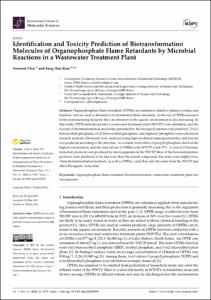GIST Scholar
College of Engineering
Department of Environment and Energy Engineering
1. Journal Articles
Identification and Toxicity Prediction of Biotransformation Molecules of Organophosphate Flame Retardants by Microbial Reactions in a Wastewater Treatment Plant
- Type
- Article
- Citation
- INTERNATIONAL JOURNAL OF MOLECULAR SCIENCES, v.22, no.10
- Issued Date
- 2021-05
- Abstract
- Organophosphate flame retardants (OPFRs) are substances added to plastics, textiles, and furniture, and are used as alternatives to brominated flame retardants. As the use of OPFRs increases in the manufacturing industry, the concentration in the aquatic environment is also increasing. In this study, OPFRs introduced into a wastewater treatment plant (WWTP) were identified, and the toxicity of biotransformation molecules generated by the biological reaction was predicted. Tris(2-butoxyethyl) phosphate, tris(2-butoxyethyl) phosphate, and triphenyl phosphate were selected as research analytes. Chemicals were analyzed using high-resolution mass spectrometry, and toxicity was predicted according to the structure. As a result, tris(1-chloro-2-propyl) phosphate showed the highest concentration, and the removal rate of OPFRs in the WWTP was 0-57%. A total of 15 biotransformation products were produced by microorganisms in the WWTP. Most of the biotransformation products were predicted to be less toxic than the parent compound, but some were highly toxic. These biotransformation products, as well as OPFRs, could flow into the water from the WWTP and affect the aquatic ecosystem.
- Publisher
- MDPI
- ISSN
- 1661-6596
- Appears in Collections:
- Department of Environment and Energy Engineering > 1. Journal Articles
Items in Repository are protected by copyright, with all rights reserved, unless otherwise indicated.
